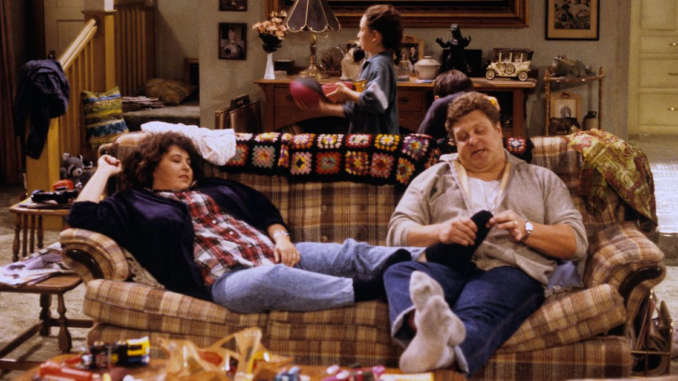
Roseanne, the groundbreaking sitcom that premiered in 1988, became a cultural phenomenon that transformed the landscape of television. It was a show that didn’t shy away from difficult topics, from poverty to addiction, from politics to family dynamics, in a way no sitcom had before. Over the years, the show’s unapologetic portrayal of a working-class American family resonated with millions of viewers, breaking through the sanitized world of TV and introducing a new form of realism to prime-time entertainment.
The Bold New Approach
When Roseanne debuted, television was still dominated by idealized families and wealthy, picture-perfect lives. Shows like The Cosby Show and Full House had set a new standard for what families on TV should look like: clean, affluent, and free from real-world struggles. Enter Roseanne, a show that showcased a middle-class family in Lanford, Illinois, living paycheck to paycheck. The Conners, led by the sharp-tongued, no-nonsense matriarch Roseanne Barr, were unlike anything viewers had ever seen before.
The show tackled the economic and emotional struggles that many families were facing but had rarely been shown on TV. Roseanne’s candid approach to topics like unemployment, marital issues, weight struggles, and child-rearing was revolutionary. She wasn’t just a funny mom—she was a real, flawed, working woman who viewers could relate to. The Conners were real people, and for many, they were a reflection of their own lives.
Breaking Barriers in Representation
Perhaps the most remarkable aspect of Roseanne was its commitment to depicting the working class. The show didn’t try to sugarcoat the challenges of life—economic hardships, job losses, and everyday family drama were front and center. Roseanne was, in many ways, the first TV matriarch who felt like someone you could meet on the street. She wasn’t a perfect mom; she was a real mom, struggling to make ends meet, cracking jokes through the tough times.
It was also the first major sitcom to feature a female character as its lead. At a time when women were often relegated to supporting roles in sitcoms, Roseanne Barr broke down the doors to create a character who wasn’t just a housewife or a sidekick. She was unapologetically herself—a strong woman with a powerful sense of humor, a bit of an edge, and a whole lot of heart.
The Influence on Future TV Shows
The success of Roseanne paved the way for other shows that followed suit in terms of authenticity and grit. Shows like The Middle, Malcolm in the Middle, and The New Adventures of Old Christine followed the blueprint of Roseanne by portraying flawed, real families. But it wasn’t just about depicting working-class life—it was about making people feel seen and heard.
The show’s impact didn’t stop with its initial run, either. In 2018, the revival of Roseanne proved that the characters and themes still had an audience. The revival generated massive interest, even though it ended prematurely due to controversy surrounding Roseanne Barr’s off-screen actions. Despite that, the revival showed that there was still a deep love for the characters and the world they inhabited. Fans had missed the Conner family, and their return to TV reminded everyone of the show’s lasting influence.
The Enduring Popularity of Roseanne
Over three decades after its debut, Roseanne remains one of the most significant sitcoms in television history. It continues to resonate with audiences because it touched on universal themes of family, survival, and humor in the face of adversity. The show’s portrayal of a working-class family in the 80s and 90s laid the groundwork for the more authentic portrayals of families on TV today.
